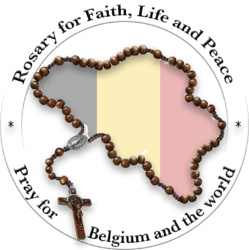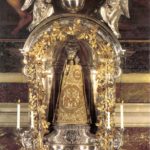Rosary for Faith, Life and Peace on 13th October 2018
From the first century onwards, the Church has always prayed to the Blessed Virgin Mary. In the 12th century, Christians praying the Ave Maria began the devotion of the “Psalterium Beatae Mariae Virginis” of 150 Ave Marias, just as the Psalter contains 150 psalms.
Henry Egher, a Carthusian monk, who died in Cologne in 1408, divided the 150 Ave Marias into 15 decades. Dominic de Prusse, also a Carthusian monk, who died in 1461, united the recitation of the decades with the contemplation of the mysteries of the life of Jesus Christ. The Dominican monk, Alain de la Roche, who died in 1475, spread the initiative of Saint Dominic de Guzman (13th century), founder of the Dominican order, who asked his faithful regularly to pray the Ave Maria.
The 150 Ave Marias include three rosaries, each one containing five decades. We call it the “Rosary”, in reference to the roses that can be seen on many paintings of Our Lady.
Popes have always recommended the recitation of the rosary. Pope Paul VI (in Marialis Cultus, 1974), who will be canonized on 14th October 2018, encouraged it strongly. Saint John Paul II (in Rosarium Virginis Mariae, 2002) added a fourth rosary (the luminous mysteries) to the existing rosary.
Since the addition of the fourth Rosary by Saint John Paul II, we have:
Joyful mysteries:
- Annunciation to Mary
- Visitation of Mary to Elizabeth
- Nativity of Jesus in Bethlehem
- Presentation of Jesus in the Temple
- Jesus’ recovery at the Temple at the age of twelve
Luminous mysteries:
- Baptism of Jesus in the Jordan
- Marriage of Cana
- Announcement of the Kingdom of God and call for conversion
- Transfiguration of Jesus
- Institution of the Eucharist
Sorrowful mysteries:
- Agony of Jesus in the Olive Garden
- Flagellation of Jesus
- Coronation of thorns
- Carrying of the Cross
- Crucifixion and death of Jesus
Glorious mysteries:
- Resurrection of Jesus
- Ascension of Jesus
- Effusion of the Spirit at Pentecost
- Dormition and Assumption of Mary
- Coronation of Mary in heaven
Not long ago, Catholic faithful from Ireland, the United Kingdom, Poland and other countries, gathered on the borders of their countries to pray the rosary.
Now, a group of Belgian faithful are encouraging all of us to pray the rosary in many places in Belgium on 13th October 2018 at 3pm, to ask Our Lady for the renewal of faith, for the protection of life and for peace of heart.
These faithful are joining with several similar initiatives which already exist in the diocese.
I encourage all those belonging to my diocese to pray the rosary together on 13th October for faith, life and peace.
+ Guy Harpigny,
Bishop of Tournai


